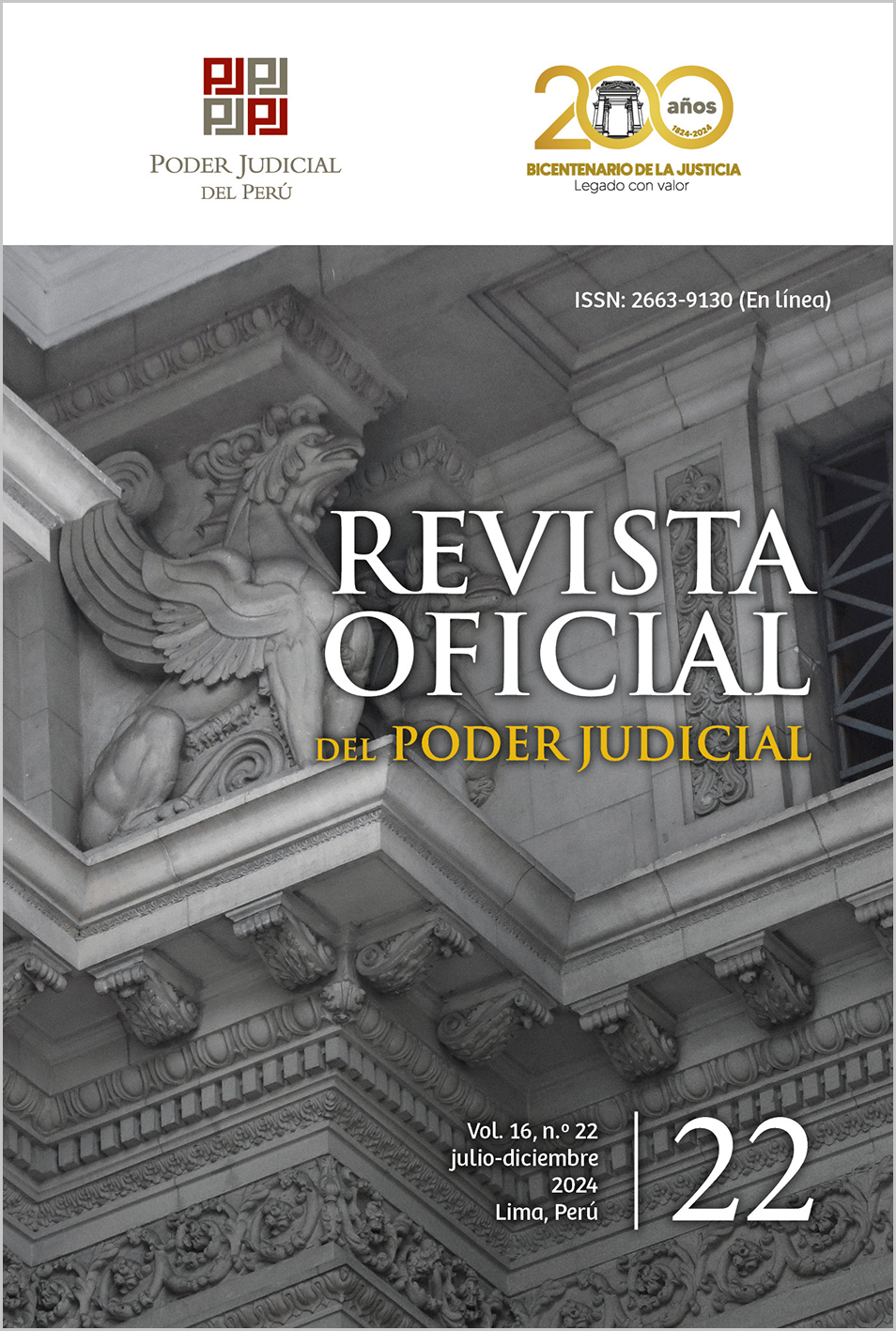Application of overruling in Peruvian law
Abstract
The overruling technique, through which courts can deviate from binding precedents and establish new ones, is a highly significant practice in law, as it enables a legal system to adapt to social demands while also addressing errors that courts may have made. Based on this premise, the objective of this article is to describe the challenges faced by the application of overruling in Peru. To achieve this, an extensive bibliographic review was conducted, as well as an analysis of cases in which this mechanism was applied. It is concluded that these challenges revolve around the reasons supporting overruling, the temporal effects its application may have, and the conditions for its use. Furthermore, it is inferred that the application of this mechanism does not undermine judicial independence; on the contrary, it prevents the rigidification of jurisdictional criteria, as it provides judicial systems with constant updates and legal certainty.
Downloads
Metrics
Métricas alternativas
References
Águila, G. (2017). El precedente constitucional. Hacia una teoría del precedente en el Perú. Revista de Ciencias Jurídicas y Sociales, 21(1), 511-522.
Álvarez, R. M. (2014). Las fuentes de conocimiento de lo jurídico. Bole- tín Mexicano de Derecho Comparado, 47(139), 39-63. http://www.scielo.org.mx/scielo.php?script=sci_arttext&pid=S0041-86332014000100002&lng=es&tlng=es
Arévalo, W. y García, L. F. (2018). La interpretación constitucional y sus métodos en el sistema jurídico norteamericano, una interacción entre lo político y lo jurídico: teorías y casos de estudio. Ius et Praxis, 24(2), 393-430. https://dx.doi.org/10.4067/S0718-00122018000200393
Baldomino, R. A. (2009). (Ir)retroactividad de las modificaciones a la norma complementaria de una Ley Penal en Blanco. Política Criminal, 4(7), 125-150. https://dx.doi.org/10.4067/S0718-33992009000100004
Botero, L. A. y Guevara, L. J. (2022, octubre-diciembre). El precedente judicial en Colombia enfrentando a la teoría expuesta por Michele Taruffo. Novum Jus, 16(3), 133-160. https://doi.org/10.14718/Novum Jus.2022.16.3.6
Carbonell, F. (2022). Variaciones sobre el precedente judicial. Una mirada desde el sistema jurídico chileno. Problema. Anuario de Filosofía y Teoría del Derecho, (16), 9-38. https://doi.org/10.22201/iij.24487937e.2022.16.17028
Castillo, L. (2009). Las posibles injusticias que genera la aplicación de la técnica del «prospective overruling». Diálogo con la Jurisprudencia, 14(129), 57-69.
Delgado, J. y Díaz, L. I. (2021). El civil law frente al precedente judicial vinculante: diálogos con académicos de América Latina y Europa. Derecho PUCP, (87), 105-138. https://dx.doi.org/10.18800/derecho pucp.202102.004
Fernández, V. (2016). La justicia de los precedentes. ¿Invasión a la independencia y autonomía del juzgador? Revista de Derecho, 29(2), 9-33. http://dx.doi.org/10.4067/S0718-09502016000200001
Islas, A. y Cornelio, E. (2017). Error judicial. Iuris Tantum. Revista Boliviana de Derecho, (24), 18-37. http://www.scielo.org.bo/scielo.php?script=sci_arttext&pid=S2070-81572017000200002&lng=es&tlng=es
Lancheros-Gámez, J. C. (2012). El precedente constitucional en Colombia y su estructura argumentativa. Síntesis de las experiencias de un sis- tema de control mixto de constitucionalidad a la luz de la sentencia T-292 de 2006 de la Corte Constitucional. Díkaion, 21(1), 159-186. http://www.scielo.org.co/scielo.php?script=sci_arttext&pid=S0120-89422012000100006&lng=en&tlng=es
Núñez, Á. (2020). ¿Violan los precedentes la IJI? Desencuentros desde la incomprensión. Derecho PUCP, (84), 303-336. https://doi.org/10.18800/derechopucp.202001.010
Núñez, Á. y Fernández, J. Á. (2021). Creación, derogación y aplicabili- dad de precedentes: a propósito de los precedentes constitucionales chilenos sobre el nasciturus. Derecho PUCP, (86), 291-321. https://dx.doi.org/10.18800/derechopucp.202101.009
Olano, H. A. (2011). Del precedente constitucional al nuevo precedente contencioso administrativo. Estudios Constitucionales, 9(2), 395-428. https://www.scielo.cl/scielo.php?pid=S0718-52002011000200010&script=sci_abstract
Raa, D. e Isern, M. (2021). La independencia del juez frente a la inconstitucionalidad de precedentes vinculantes establecidos por el Tribunal Constitucional peruano. Estudios Constitucionales, 19(1), 146-182. http://dx.doi.org/10.4067/S0718-52002021000100146
Risso, M., Garat, M. P., Asencio, D., Brun, M., Carrique, A., Furtado, B., Hernández, B., Martínez, E., Menéndez, S. Moglia, B., Painceira, S. y Pereyra, F. (2022, enero-junio). El principio de igualdad en la jurisprudencia de la Suprema Corte de Justicia de Uruguay. Resultado de investigación. Revista de Derecho, (25), 203-223.
Sierra, D. (2016, enero-junio). El precedente: un concepto. Revista Derecho del Estado, (36), 249-269. http://www.scielo.org.co/scielo.php?script=sci_arttext&pid=S0122-98932016000100009&lng=en&t lng=es
Sodero, E. (2004). Sobre el cambio de los precedentes. Isonomía, (21), 217-251. http://www.scielo.org.mx/scielo.php?script=sci_arttext&pi d=S1405-02182004000200008&lng=es&tlng=es
Fuentes normativas y jurisprudenciales
Expediente n.o 3361-2004-AA/TC (2005). Tribunal Constitucional (12 de agosto de 2005).
Expediente n.o 3741-2004-AA/TC (2005). Tribunal Constitucional (14 de noviembre de 2005).
Expediente n.o 01412-2007-PA/TC (2009). Tribunal Constitucional (11 de febrero de 2009).
Copyright (c) 2024 Edwin Adolfo Morocco Colque

This work is licensed under a Creative Commons Attribution 4.0 International License.
The authors retain their copyrights and register under the Creative Commons Attribution 4.0 International License (CC BY 4.0), which allows the use of the published material (adapt - remix, transform and build - and share - copy and redistribute - the material in any medium or format).
1. The journal allows authors to retain their copyrights of submitted articles without any restrictions.
2. Authors retain the right to share, distribute, copy, perform and publicly communicate the article published in Revista Oficial del Poder Judicial (e.g., place it in an institutional repository).
3. Authors retain the right to make a subsequent publication of their work, to use the article or any part of it (for example: a compilation of their work, notes for conferences, thesis, or for a book), as long as they indicate the source of publication (authors of the work, journal, volume, number and date).






















